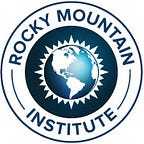The Past Is Prologue
35 years of impact have set the stage for accelerating the energy revolution
By Jules Kortenhorst, chief executive officer at Rocky Mountain Institute.
This April marked the 35th anniversary of Rocky Mountain Institute’s founding in 1982. As I survey the past three and half decades and try to peer as far into the future, I am filled with amazement at how far the energy transformation has come, with urgency because of how much it is now needed, and with optimism about the gathering strength of the energy revolution. While it is true that the current U.S. federal government administration is not leading the effort to transform the world economy to a low-carbon, resilient, and sustainable future, the transition is now global, widely supported, increasingly cost-effective, and therefore irreversible.
Look at what markets, aided by pioneers like RMI, have achieved. In 2015, the world used energy 32 percent more efficiently than 25 years earlier, even while the world economy more than doubled in size, according to the U.S. Energy Information Administration. And globally, renewables have been the leading new energy source for two years in a row, at decreasing cost.
At RMI, we know that when markets lead, policy and politics follow. Last year’s historic Paris Agreement is a thrilling development, but the vanguard of the energy transformation to renewables and efficiency will continue to be market based. That is why I’m confident that together, we can avert catastrophic climate change and achieve a clean, prosperous, and secure low-carbon future.
LOOKING BACKWARD AND FORWARD
In this issue of Solutions Journal, Amory takes stock of Rocky Mountain Institute’s influence on the mobility, buildings, electricity, and many other industries over the past 35 years. And Sir Richard Branson describes how RMI’s agility has been enhanced by the bold, entrepreneurial legacy of Carbon War Room, which merged with and now operates as part of RMI, weaving the innovative carbon reductions that are its hallmark into our DNA.
But the urgency of the present moment does not allow us to rest on our laurels; the planet’s climate is at a crisis, which is why the past is merely a prologue to what we must do now, and in the future.
In our main feature article, “35 Audacious Ideas,” you will read about dozens of ways we are working to accelerate and deepen our impact on the energy transition. Some are achievements of the present moment, whereas others are very ambitious — but attainable — plans for the future. And the projects show how our intervention model works to unlock markets in all sorts of ways.
Sometimes we identify a new technology or solution to apply to energy, like the blockchain technology that underlies the bitcoin digital currency, which has the potential to transform the way distributed energy technologies like rooftop solar and demand response can be orchestrated and compensated.
Sometimes markets, or individual market actors, develop transformative technologies but don’t have the long-term view or immediate incentives to see how they can work together to effect change that is more than the sum of its parts. Our work with the city of Austin, Texas, to pioneer a complete mobility ecosystem that will build toward electric, autonomous Mobility as a Service is an example of our whole-systems view.
And sometimes markets just don’t extend far enough, and so RMI takes action. Solar energy is cheaper than ever, but it takes bold intervention to see that it reaches the populations that can benefit most from it — another project you’ll read about in these pages.
SHAPING THE FUTURE
As I look to the next 35 years, I see with excitement the work that RMI is carrying out in China, where we are helping with a vast and ambitious energy transition, and I see with growing confidence our initial work on mobility in India. Although our work there is just beginning, our collaboration with the government and business leaders of that nation has been tremendously encouraging, and India’s enormous strength in information technology and mastery of innovation promise much for our support of its mobility transformation — another feature story in this issue.
So RMI moves out into the world, and forward into the future, with resolve that our task is both an urgent and a vital one, and with hope that our efforts, with your help, will meet the challenge. Our theory of change begins with you, and supporters like you. Your support over the past 35 years helped us to find solutions, pioneer and pilot new energy approaches, and collaborate with diverse partners. And those partners — public and private, for-profit and academic, foreign and domestic — helped us to bring our solutions and our approaches to global scale, so that what was merely a gleam in Amory’s eye 35 years ago is now rolling off production lines from Stuttgart to Detroit. With your help, the future belongs to clean, renewable, efficient, cost-effective energy. I know the best is yet to come.
Jules Kortenhorst is chief executive officer of Rocky Mountain Institute.
GET INVOLVED
Philanthropic support makes RMI’s work possible. Join us by making a donation today to help create a clean, prosperous, and secure low-carbon future.
Give an unrestricted gift or target your gift to support an RMI project that addresses your passion. www.rmi.org/donate
